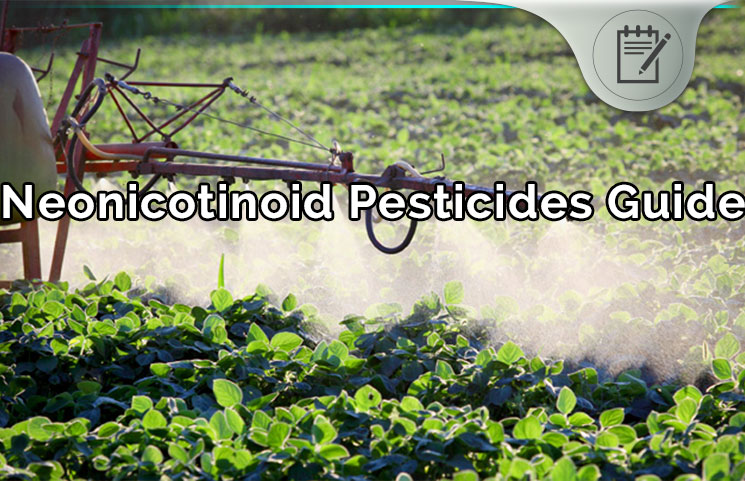What Are Neonicotinoid Pesticides?
Neonicotinoid Pesticides are a new class of neuroactive insecticides that are chemically related to nicotine. They are more toxic to insects than they are to larger animals, such as mammals and birds.
The popularity of neonicotinoid pesticides in pest control has surged due to their high water solubility. Their solubility in water allows them to be applied in soil and then be absorbed by plants.
The use of these insecticides came under scrutiny in the 1990s, due to their adverse effects on the environment. The chemicals were linked to adverse environmental effects, such as Honeybee Colony Collapse Disorder.
A reduction in the insect population also led to a decline in the bird population. However, some few non-European countries along with the European Union restricted the use of certain neonicotinoids in the 2013.

The Mechanism Of Action Of Neonicotinoid Pesticides
The mechanism of action of these pesticides is modeled after nicotine. Neonicotinoid pesticides act on the central nervous system of insects, which causes paralysis for the insect, and then is followed by death.
Neonicotinoids work best against sucking insects. They also work well against chewing insects, such as beetles and Lepidoptera, including cutworms.
The Uses Of Neonicotinoid Insecticides
Neonicotinoid Pesticides are used in agriculture to prevent the destruction of plants. They act systemically, and they have a particular efficacy against sucking insects. The insecticides can even be added to the water that is used for plant irrigation. They are applied to seed, timber, soil, and animal feed to protect them from pests.
Farmers from the United States have used neonicotinoid pesticides on about 95 percent of canola and corn plants. The insecticides have also been used heavily on vegetables and fruits such as peaches, tomatoes, leafy greens, cherries, and potatoes.
The effectiveness of neonicotinoids against pests depends on the timing of planting and the arrival of the pests. For example, the pesticides are not effective against the soybean aphid pest because the compounds degrade 40 days after planting. Soybean aphids are typically not present before the 40 days have expired.
The pesticides can be used to protect plants in special cases, such as late-planted plants. They are also effective in areas that have large infestations much earlier in the growing season.
Effects Of Neonicotinoids On The Environment
Evidence shows that the use of these insecticides could be putting pollinators, such as bees and butterflies, at risk. The chemicals have been shown to have adverse effects to the population of honeybees, wild bees, butterflies, and bumblebees.
Researchers from California came to the conclusion that neonicotinoids are the primary cause of the reduction in butterfly population in Northern California.
Scientists from the University of Nevada tracked 67 different species of butterflies within four different areas for 20 years. The researchers found out that the decline in the number of butterflies in the four different locations is linked to the rise in the use of neonicotinoid insecticides.
Other past studies have also linked the use of these insecticides to the overall decline of insects, which can have a harmful impact on the environment. In England, it was reported that the butterfly species has declined by 58 percent on farmed land between 2000 and 2009.
According to researchers, neonicotinoid insecticides can harm bees. When plants are treated with these chemicals, all parts of the plant become toxic to bees. The powerful neurotoxicity of these chemicals makes them destructive to pollinators, such as bees, which are not harmful to the plant.
The plant takes the chemicals through its vascular system as it grows, and as a result, the chemicals become expressed in the nectar and pollen of the plant, which poisons the bee population.
A study found that the different products containing neonicotinoid insecticides may affect bees differently. Imidacloprid, which is manufactured by Bayer, causes harm to bees by cutting the number of egg-containing brood cells by 46 percent. Thiamethoxam, which is produced by Syngenta, reduced the population of live bees by 38 percent.
Clothianidin, which is also manufactured by Bayer, was found to increase the number of queens. However, scientists caution that the queens could turn out to be infertile. A representative for Bayer Crop Science in the United Kingdom stated that the decline in the population of the pollinators could be due to intensive agricultural activities and not just the use of neonicotinoid insecticides.
The European Union banned the use of neonicotinoid pesticides beginning 2013 to investigate their involvement with the decline of the bee population.
The American Bird Conservancy published a commentary in March 2013 calling for a ban on the use of neonicotinoid insecticides. According to the organization, the chemicals are also toxic to birds, aquatic invertebrates, and other wildlife animals.
A study was conducted by Dutch researchers to find the effect of neonicotinoids to invertebrates living in water. The study revealed that the water containing an allowable amount of the chemicals had 50 percent fewer invertebrate species than water that had not been contaminated with the insecticides.
Products That Contain Neonicotinoid Pesticides
1. Clothianidin
The neonicotinoid insecticide was developed jointly by Bayer and Takeda Chemical Industries. The chemical is used as an alternative to nicotine, which degrades rapidly. Clothianidin was also developed to replace the old insecticides, which were harmful to humans and other mammals.
It has been used to prevent pests that have developed resistance to other insecticides, such as carbamates and organophosphates. The killing of non-target insects, such as bees and butterflies, is the major risk that is associated with the use of Clothianidin.

2. Imidacloprid
Imidacloprid is a systemic insecticide that is used to prevent pest infestation in the soil, timber, rice hoppers, and cereals among others. It works by inhibiting the transmission of chemicals in the nervous system of the insect. The blockage of chemical transmissions leads to paralysis and death of the insect.
Products containing Imidacloprid are available in different formulations, including dustable powder, granular, suspension concentration, and wettable powder. According to studies, Imidacloprid also has some adverse chemical effects to the environment.
The chemical is toxic to upland game birds, and it is also toxic to aquatic animals, such as fish. The chemical is also toxic to bees when it is used as a foliar application.
3. Acetamiprid
It is a neonicotinoid insecticide that is odorless and composed from a synthetic organic compound. It works by blocking chemical transmission in the nervous system, leading to paralysis and death.
Neonicotinoid Pesticides Conclusion
When these chemicals are used appropriately, they produce minor effects on bees and other organisms. To minimize their effect on these creatures, it is advisable to follow the directions on the label carefully.
To help keep the pollinator population stable, it is also important to restrict the application of the chemicals to the soil or for use only during period when bees and butterflies are not foraging.









